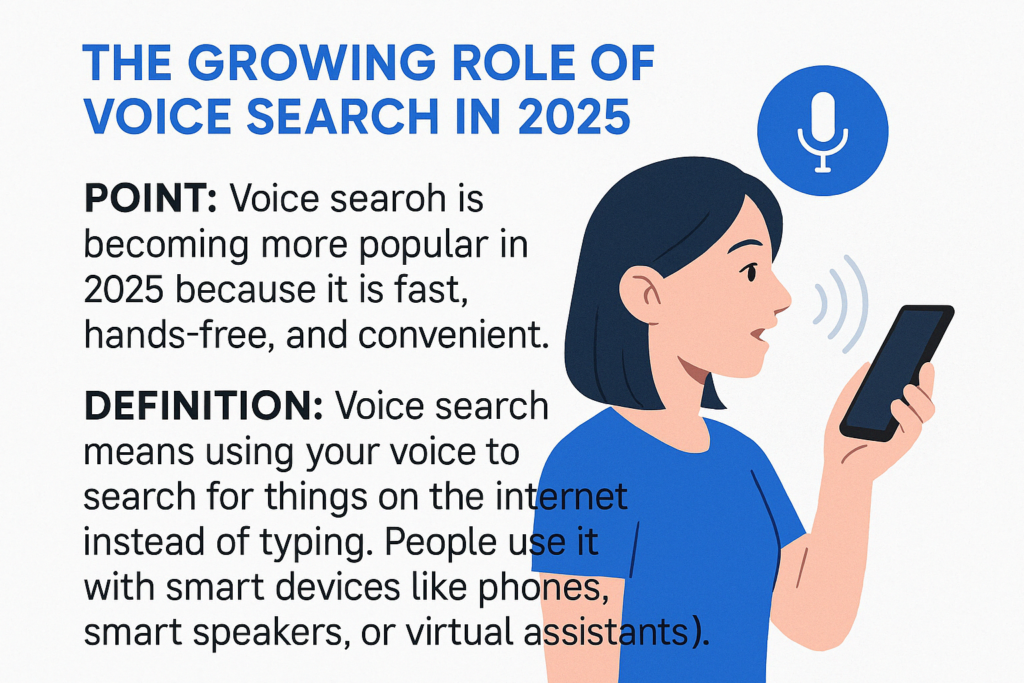Currently Empty: ₹0.00
Voice Search Optimization: How to Rank in 2025
Online searches are changing as a result of voice search. Voice search is quickly taking over as the primary way to obtain information, from asking Siri what the weather is like to instructing Alexa to place a dinner order. According to analysts, voice-activated searches will account for 75% of all queries by 2025 (PwC). It is impossible to overlook this change as a marketer, content provider, or business owner. if voice search optimization is not being done.
This blog post will explain the issue, its importance to your company, and how to use voice search optimization techniques to get ready for this change. To make sure you comprehend the urgent issues and doable actions for optimizing your content for voice search in 2025, we’ll break it down using the PAS (Problem-Agitate-Solution) methodology.
Problem: The Growing Role of Voice Search in 2025

The Rise of Voice Search
Voice search is now a necessary component of daily living rather than just a “cool” technological fad. Google reports that 41% of adults and 55% of teenagers use voice search on a daily basis. Voice search has become ingrained in our daily lives, whether we are asking simple questions like “What’s the weather today?” or more complex ones like “What’s the best sushi restaurant in my area?”
However, the rise of voice assistants and smart speakers is the true game-changer here. A smart speaker is predicted to be owned by almost 75% of American households by 2025, and that’s only one component of the picture. Voice search is the most widely used way for rapid, hands-free queries since people are utilizing voice assistants on their smartphones, tablets, and even smart TVs.
What is the issue for companies? Traditional text search is considerably different from voice search. People typically ask conversational questions when using voice search. Examine the two:
“Best coffee shops NYC” is a text search query.
“Hey Siri, where can I find the best coffee near me?” is an example of voice search.
As you can see, voice search inquiries are typically lengthier, more question-based, and more natural. This implies that companies that wish to remain relevant in 2025 must reconsider their SEO tactics.
Why Traditional SEO is Falling Short
The standard SEO tactics that were effective for text-based searches could no longer be sufficient. Direct, conversational responses are more important in voice search results than specific keywords. It’s time to make changes if your website is still set up using antiquated keyword-stuffing techniques. Because of this change, placing in the top 10 search results is no longer as crucial as it once was.Voice Search Optimization, The action in voice search takes place in position zero, which is often referred to as the featured snippet.
Consider this: users typically don’t have time to go through a page of search results when they use voice search. Rather, they seek prompt, pertinent responses. Featured snippets (position zero) are crucial for voice search optimization because of this. These bits of information are being extracted by voice assistants to give users prompt, succinct answers.
Take a look at this Blue Corona case study sample. To increase their voice search presence, they collaborated with a nearby HVAC firm. Within six months, the company saw a 37% increase in voice search traffic by refocusing on long-tail keywords and question-based questions. This demonstrates unequivocally that companies that prioritize voice search optimization can benefit greatly.
Agitate: Why You Can’t Afford to Ignore Voice Search
The Impact of Voice Search on Consumer Behavior
Voice search is no longer just a novelty; it’s a fundamental shift in how consumers interact with the internet. Recent data from Google reveals that over 72% of voice search users rely on it to find local businesses (Google). And when people use voice search, they often expect instant answers. Speed is crucial, and the way voice search results are delivered is changing the search landscape altogether.
Think about it: when people use voice search, they usually don’t have time to scroll through a page of search results. Instead, they want immediate, relevant answers. That’s why featured snippets (position zero) are so important for voice search optimization. Voice assistants are pulling information from these snippets to provide users with fast, concise responses. If your content isn’t optimized for this format, you’re not even in the race.
Consider this example from a case study with Blue Corona. They worked with a local HVAC company to improve their voice search visibility. By shifting the company’s focus to long-tail keywords and question-based queries, they were able to see a 37% increase in voice search traffic within just six months. This is clear evidence that businesses that focus on voice search optimization can reap significant rewards.
Voice Search and Local Search: A Match Made in Heaven
Local intent is closely related to voice search. Local businesses account for 80% of voice search queries (BrightLocal). People utilize voice search to locate local businesses and services, whether they are asking for something like “Where’s the closest gym?” Voice Search Optimization or “Find me a 24-hour pharmacy near me.” For companies trying to stay visible in local search results, this poses a special problem.
Take a look at these trends:
- 72% of voice search users are looking for businesses within 5 miles of their location (Google).
- 50% of people who search for local businesses on their smartphones visit a store within 24 hours (Google).
If your business doesn’t rank well for local queries, you’re missing out on an enormous segment of potential customers. But if you focus on optimizing for voice search, especially for local searches, you can position yourself as the go-to answer in your area.
Solution: How to Rank in Voice Search in 2025

Now that we’ve explored the challenges, let’s dive into the solutions. Here’s how you can optimize your website and content for voice search in 2025.
1. Use Conversational Keywords
Voice search queries are conversational. People don’t just type in a few keywords like “best hotels New York.” They ask full questions: “What are the best hotels in New York?” or “Which hotel is closest to Central Park?”
Actionable Tip: Shift your focus to long-tail, question-based keywords. These kinds of searches are more natural and reflect the way people speak. You should also think about the context of the questions users might ask. Consider these:
- “What is…”
- “How to…”
- “Where can I…”
- “Why does…”
- “What’s the best…”
Incorporating conversational phrases into your content will make it easier for voice search algorithms to pull your content as the answer to a user’s query.
2. Target Featured Snippets (Position Zero)
As mentioned earlier, position zero is crucial for voice search. When a voice assistant answers a query, it often pulls data from the featured snippet. So how do you get there?
Actionable Tip: To optimize for featured snippets:
- Answer questions directly and concisely, ideally within the first 40-50 words of your content.
- Use bullet points or numbered lists for easy-to-digest answers.
- Optimize your headings (H1, H2, etc.) to match the types of questions people are likely to ask.
- Use structured data (schema markup) to help search engines understand your content.
Featured snippets are highly valuable for voice search, so don’t overlook this optimization.
3. Focus on Local SEO
Given that 72% of voice search users are looking for local businesses, optimizing your website for local SEO is essential. This means you need to be visible when users ask for businesses near them.
Actionable Tip:
- Set up and optimize your Google My Business (GMB) profile.
- Make sure your Name, Address, and Phone Number (NAP) are consistent across all platforms.
- Encourage local reviews on Google and other local directories.
- Use local keywords in your content, and create localized blog posts or pages to target city-specific queries.
By improving your local SEO, you can capture voice search traffic from users actively looking for nearby businesses.
4. Ensure Your Website Is Mobile-Friendly and Fast
Voice search is almost always used on mobile devices, so your website needs to be mobile-responsive and fast-loading. If your site takes too long to load, voice search users will leave and look for a faster, more responsive site.
Actionable Tip: Use tools like Google’s PageSpeed Insights to test your site’s performance. Aim for a load time under 3 seconds, and ensure your site works seamlessly on smartphones and tablets.
5. Use Structured Data (Schema Markup)
Structured data helps search engines understand the content on your pages and increases your chances of appearing in voice search results.Voice Search Optimization, This is especially important for featured snippets and other rich results.
Actionable Tip: Implement schema markup on your website to improve the chances of your content being featured in rich snippets or answer boxes. Tools like Google’s Structured Data Markup Helper can make this process easier.
Conclusion: Voice Search Is Here to Stay—Adapt or Fall Behind
Voice search is not a passing trend—it’s the future. By 2025, it’s predicted that over 75% of all searches will be voice-driven. If you don’t optimize your website and content for this shift, you risk falling behind your competitors.
To rank in voice search in 2025, focus on the following:
- Use conversational keywords that reflect how people speak.
- Target featured snippets to appear in voice search results.
- Optimize for local SEO to capture traffic from
1. What distinguishes voice search queries from conventional text searches?
In contrast to conventional text searches, voice search questions are usually lengthier, more conversational, and more organic. Voice search users typically speak in whole sentences that are frequently framed as queries. “Best pizza NYC” is an example of a typical text search, whereas “Hey Google, where can I find the best pizza near me?” is an example of a voice search.
Because of this change, companies must optimize their content to match the speech patterns of their target audience. Long-tail, question-based keywords that align with how people naturally engage with voice assistants should be your main focus rather than short keywords.
2. What makes voice search crucial for 2025 SEO?
Voice search is becoming a crucial component of digital device interaction. According to PwC, 75% of all searches will be voice-based by 2025. Businesses must modify their SEO tactics to be found in this new search environment as more consumers use voice assistants like Alexa, Google Assistant, and Siri for daily chores.
Users’ access to information is altered by voice search, which yields more conversational and instantaneous results. Optimizing for featured snippets will be essential to ranking highly in voice search results because voice searches frequently pull directly from these snippets.
Users’ access to information is altered by voice search, which yields more conversational and instantaneous results. Optimizing for featured snippets will be essential to ranking highly in voice search results because voice searches frequently pull directly from these snippets.
3. What function do voice search’s featured snippets (position zero) serve?
That show up above standard search results and offer a succinct, straightforward response to a query are called featured snippets, or position zero. In order to answer user questions, voice assistants frequently extract information from these snippets.Voice Search Optimization.
Why it matters: According to Backlinko, highlighted snippets account for nearly 40% of voice search results. Optimizing your content to show up here is essential if you want to rank highly in voice search. This entails answering frequently requested questions in a clear and succinct manner and utilizing structured data, or schema markup, to increase your chances of being included in a featured snippet.
4-How can I optimize voice search for conversational keywords and natural language?
voice search queries are longer than text-based searches and frequently employ natural language. You should aim for long-tail, question-based keywords that represent the genuine speech patterns of individuals rather than short keywords. Voice Search Optimization.For instance, optimize for terms like “What are the best Italian restaurants near me?” rather than just “best restaurants.”
Steps to Take:
- Incorporate question terms such as “how,” “what,” “where,” and “why” into your writing.
- Include conversational, organic language that reflects the way individuals ask questions.
- To improve your chances of being included in featured snippets, concentrate on giving clear answers to queries early in your writing. https://jioskill.com







